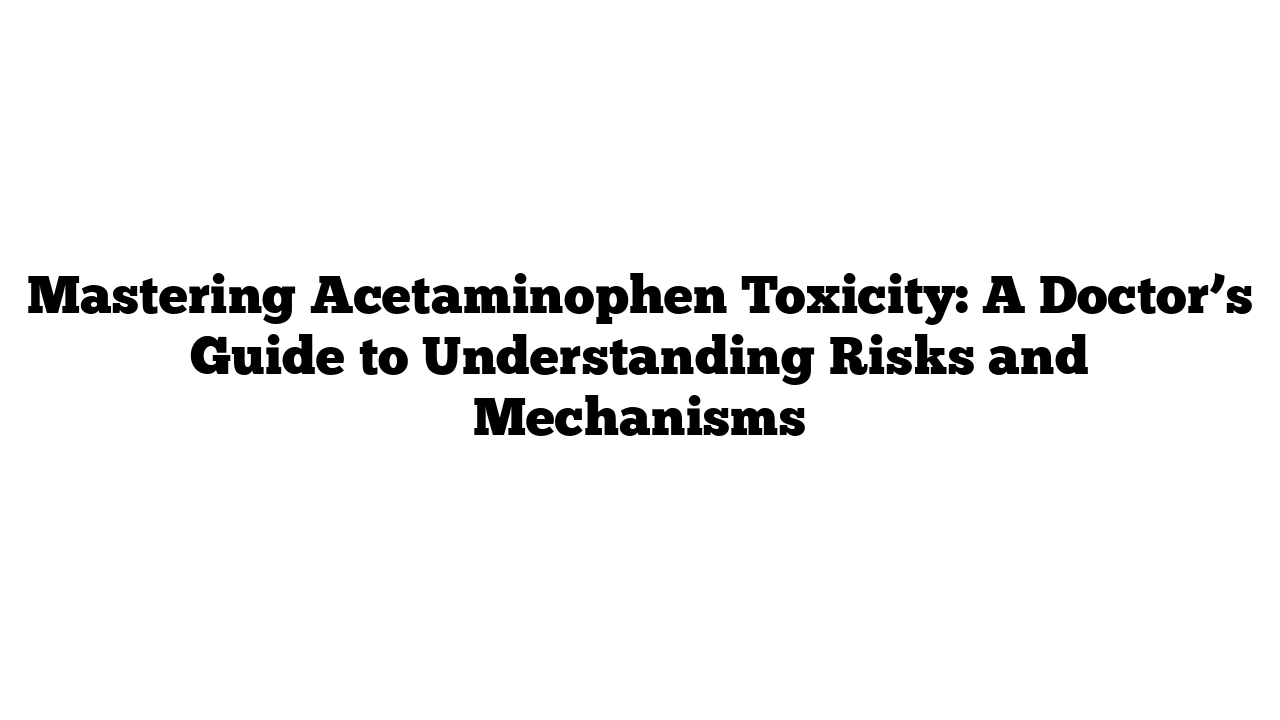Understanding Acetaminophen Toxicity: The Hidden Risks
Acetaminophen, also known as paracetamol, is one of the most commonly used medications for pain relief and fever reduction in the USA and worldwide. While it is effective when used properly, it is also a leading cause of acute liver failure in many countries, particularly in cases of overdose, accidental or intentional.
This article provides an in-depth look at the mechanisms of acetaminophen toxicity, exploring how the drug interacts with the liver, what happens during an overdose, and why timely intervention is critical.
How Acetaminophen Works in the Body
Acetaminophen is processed primarily in the liver, where it undergoes several chemical reactions before being eliminated from the body through urine. This process involves two main routes:
- Direct Route (90%):
- The liver metabolizes most of the drug in a single step, creating a non-toxic byproduct that travels to the kidneys for excretion.
- Indirect Route (Up to 8%):
- A smaller portion of acetaminophen is processed using a specialized liver enzyme system called cytochrome P450 (CYP450).
- This pathway creates a toxic byproduct known as N-acetyl-p-benzoquinonimine (NAPQI). Normally, glutathione, a protective liver molecule, neutralizes NAPQI, converting it into a harmless substance that can be excreted by the kidneys.
- Minimal Direct Excretion (2%):
- A tiny fraction of acetaminophen bypasses the liver and goes straight to the kidneys without processing.
What Happens During an Overdose?
When someone consumes too much acetaminophen—such as the 6,000 mg dose taken by a patient in a case study—it overwhelms the liver’s metabolic system. Let’s use a train analogy to simplify this process:
- The express train represents the liver’s ability to process acetaminophen through the direct route (90%).
- The slow train symbolizes the indirect route, which relies on glutathione to neutralize NAPQI.
- The connecting train (glutathione) can only handle a limited number of passengers (toxic byproducts).
In an overdose:
- The express train reaches full capacity, leaving many “passengers” (acetaminophen molecules) to take the slow train.
- As more passengers arrive at the “NAPQI stop,” the available glutathione (connecting train) becomes overwhelmed.
- Excess NAPQI builds up, binding to liver proteins and causing irreversible liver damage.
Symptoms of Acetaminophen Overdose
Patients who overdose on acetaminophen may initially experience mild symptoms, which can worsen over time:
- Early Symptoms (Within 24 hours):
- Nausea, vomiting, abdominal pain (especially in the upper right quadrant), and confusion.
- Progressive Symptoms:
- Liver inflammation releases enzymes AST and ALT, detectable in blood tests.
- Prolonged clotting times due to impaired production of clotting proteins.
- Severe cases lead to jaundice, bleeding, and even coma.
Why Prompt Treatment Is Crucial
If untreated, the buildup of NAPQI results in:
- Liver Cell Death: Proteins in liver cells become inactive, leading to cell death.
- Inflammation and Scarring: Chronic damage causes permanent scarring (cirrhosis), leaving the liver unable to function.
- Liver Failure: Without a functioning liver, patients require a liver transplant to survive.
How to Manage Acetaminophen Overdose
Early medical intervention is key. Treatment typically involves:
- Activated Charcoal (within 4 hours): To prevent further absorption of the drug.
- N-Acetylcysteine (NAC):
- Administered intravenously or orally, NAC replenishes glutathione levels, helping neutralize NAPQI.
- Most effective when given within 8-10 hours of ingestion, but it can still provide benefits later.
Prevention Tips
- Follow Dosage Guidelines: Adults should not exceed 4,000 mg per day (lower limits for children).
- Avoid Combining Products: Many cold and flu medications contain acetaminophen. Read labels carefully to avoid unintentional overdoses.
- Store Safely: Keep medications out of reach of children to prevent accidental ingestion.
- Educate on Risks: Spread awareness about the dangers of overdosing, particularly among adolescents.
A Case to Remember
The story of a 16-year-old girl in the USA illustrates the dangers of acetaminophen overdose. Despite her parents’ prompt action, the girl presented with vomiting, confusion, and abdominal pain. Blood tests confirmed liver damage. Early intervention with N-acetylcysteine likely saved her life, preventing permanent liver failure.
Final Thoughts on Acetaminophen Safety
While acetaminophen is a safe and effective medication when used correctly, overdose can have life-threatening consequences. Being informed about proper dosing, recognizing symptoms of toxicity, and seeking immediate medical attention can make all the difference.
For more reliable health information, visit medicaltimes.io.
Reference Websites:
- CDC on Acetaminophen Overdose
- Mayo Clinic: Acetaminophen Safety
- NIH LiverTox: Acetaminophen Toxicity
Top 10 FAQs on Acetaminophen Toxicity
- What is acetaminophen commonly used for?
It’s used to relieve pain and reduce fever. - How much acetaminophen is too much?
Exceeding 4,000 mg per day for adults or combining multiple medications with acetaminophen can be dangerous. - What are the early symptoms of overdose?
Nausea, vomiting, abdominal pain, and confusion. - What is NAPQI?
A toxic byproduct of acetaminophen metabolism that can damage liver cells if not neutralized. - What does N-acetylcysteine (NAC) do?
NAC restores glutathione levels, helping the liver neutralize NAPQI. - How soon should treatment start after an overdose?
Within 8-10 hours for the best outcomes, though later treatment can still help. - Can children safely use acetaminophen?
Yes, but only in age-appropriate doses as directed by a doctor. - Is liver damage from acetaminophen reversible?
Early treatment can reverse damage, but severe cases may require a liver transplant. - Why is acetaminophen included in so many medications?
It’s effective and widely tolerated when used correctly. - How can I prevent accidental overdose?
Always check labels and consult your doctor when taking multiple medications.
